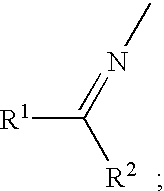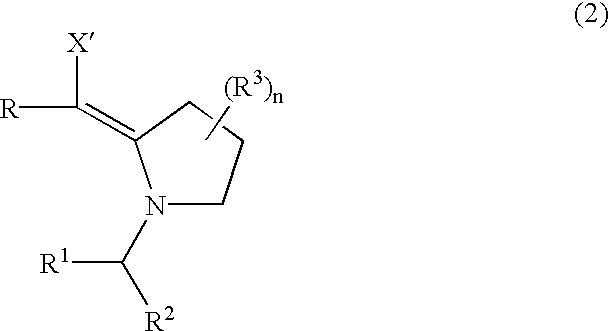Amination process
a technology of amination process and a bonding process, which is applied in the field of synthetic organic chemistry, can solve the problems of inherently limited strategy, inability to meet the mild conditions necessary for the highest degree of chemoselectivity, and limited substrate generality of these methodologies,
- Summary
- Abstract
- Description
- Claims
- Application Information
AI Technical Summary
Problems solved by technology
Method used
Image
Examples
example 1
[0098] 20
[0099] N-(1-Methylbenzyl)indoline (2a).
[0100] Following the general procedure, o-bromophenethylamine (46 mg, 231 mmol), acetophenone (27 .mu.L, 231 mmol), and 4 .ANG. MS were stirred in benzene (1 mL) at room temperature for 12 h. Filtering of the mixture through Celite and removal of the solvent provided the ketimine as a >95:5 mixture of stereoisomers. IR (film) 3056, 1633 cm.sup.-1; .sup.1H NMR (400 MHz, CDCl.sub.3) .delta.7.78 (m, 2H), 7.57 (d, J=6.9 Hz, 2H), 7.40 (t, J=3.1 Hz, 3H), 7.34 (d, J=6.0 Hz, lH), 7.26 (t, J =6.3 Hz, 1H), 7.10 (t, J=6.0 Hz, 1H), 3.79 (dd, J=7.8, 7.8 Hz, 2H), 3.22 (dd, J=7.8, 7.8 Hz, 2H), 2.17 (s, 3H); .sup.13C NMR (100 MHz, CDCl.sub.3) ppm 166.0, 142.0, 140.0, 133.0, 131.7, 129.7, 128.5, 128.1, 127.6, 126.9, 52.2, 37.8, 18.1; HRMS (EI): Exact mass calcd for C.sub.16H.sub.16BrN [M+H].sup.+, 302.0544. Found 302.0516.
[0101] A three hour addition of a .sup.nBu.sub.3SnH (68 .mu.L, 0.25 mmol) and AIBN (15 mg, 93 .mu.mol) solution in benzene (0.7 mL) ...
example 2
[0102] 21
[0103] N-(1-Trifluoromethyl)benzyl indoline (2b).
[0104] Following the general procedure, o-bromophenethylamine (852 mg, 4.25 mmol), trifluoroacetophenone (590 pL, 4.21 mmol), and 4 .ANG. MS were stirred in toluene (10 .mu.L) at room temperature for 12 h to provide the ketimine as a >95:5 mixture of stereoisomers. IR (film) 3062, 1669 cm.sup.-1; .sup.1H NMR (400 MHz, CDCl.sub.3) .delta. 7.49 (d, J=7.9 Hz, 1H), 7.44 (t J=7.4 Hz, 1H), 7.38 (t, J=7.1 Hz, 2H), 7.24 (t, J=7.4 Hz, 1H), 7.18 (d, J=6.0 Hz, 1H), 7.10 (t, J=6.0 Hz, 1H), 6.94 (d, J 7.1 Hz, 2H), 3.69 (dd, J=7.1, 7.1 Hz, 2H), 3.13 (dd, J=7.1, 7.1 Hz, 2H); .sup.13C NMR (100 MHz, CDCl.sub.3) ppm 138.4, 133.0, 131.7, 130.3, 130.1, 128.8, 128.4, 127.7, 127.5, 124.9, 52.8 36.8; HRMS (EI): Exact mass calcd for C.sub.16H.sub.13F.sub.3N [M--Br].sup.+, 276.1000. Found 276.1003.
[0105] A three hour addition of .sup.nBu.sub.3SnH (184 .mu.L, 682 .mu.mol) and AIBN (41 mg, 248 .mu.mol) solution in benzene (2.5 mL) to a refluxing soluti...
example 3
[0106] 22
[0107] N-(1-Phenylbenzyl)indoline (2c).
[0108] Following the general procedure, o-bromophenethylamine (471 mg, 2.35 mmol) and benzophenone imine (426 mg, 2.35 mmol) were stirred for 12 h in dichloromethane (4 mL). Removal of the solvent provided the ketimine. IR (film) 3056, 1660, 1623 cm.sup.-1; .sup.1HNMR (400 MHz, CDCl.sub.3) .delta.7.61 (d, J=6.8Hz, 2H), 7.49 (d, J=7.0 Hz, 1H), 7.40 (m, J=3.8 Hz, 3H), 7.35 (m, J=7.0 Hz, 3H), 7.24 (t, J=5.8 Hz, 1H), 7.19 (d, 6.8 Hz, 1H), 7.05 (t, J=5.8 Hz, 1H), 6.98 (m, J=3.8 Hz, 2H), 3.68 (dd, J=7.2, 7.2 Hz, 2H), 3.14 (dd, J=7.4, 7.4, Hz, 2H); .sup.13C NMR (100 MHz, CDCl.sub.3) ppm 169.0, 140.0, 139.8, 136.9, 132.9, 131.6, 130.1, 128.65, 128.61, 128.4, 128.2, 127.9, 127.4, 125.0, 53.6, 37.9; HRMS (CI): Exact mass calcd for C.sub.21H.sub.18BrN [M+H].sup.+, 364.0701. Found 364.0596.
[0109] A three hour addition of a .sup.nBu.sub.3SnH (70 .mu.L, 254 .mu.mol) and AIBN (5 mg, 9.2 .mu.mol) solution in benzene (1.0 mL) to a refluxing solution of...
PUM
| Property | Measurement | Unit |
|---|---|---|
| temperature | aaaaa | aaaaa |
| temperature | aaaaa | aaaaa |
| pH | aaaaa | aaaaa |
Abstract
Description
Claims
Application Information
 Login to View More
Login to View More - R&D
- Intellectual Property
- Life Sciences
- Materials
- Tech Scout
- Unparalleled Data Quality
- Higher Quality Content
- 60% Fewer Hallucinations
Browse by: Latest US Patents, China's latest patents, Technical Efficacy Thesaurus, Application Domain, Technology Topic, Popular Technical Reports.
© 2025 PatSnap. All rights reserved.Legal|Privacy policy|Modern Slavery Act Transparency Statement|Sitemap|About US| Contact US: help@patsnap.com



